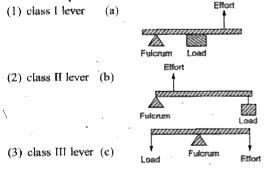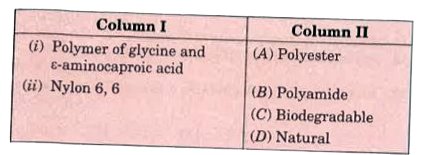Match the pictures to the class of levers:

Video Solution
Text Solution
(1)-(c) (2)-(a) (3)-(b)
|
Similar Questions
Knowledge Check
Match the drug (column I) with the class of drug (colum n II).
 A(i)- (C) , (ii) - (B)B(i) - (A) , (ii) - (B)C(i) - (C), (ii) - (D)D(i) - (B) , (ii) - (C)
A(i)- (C) , (ii) - (B)B(i) - (A) , (ii) - (B)C(i) - (C), (ii) - (D)D(i) - (B) , (ii) - (C)The example of lever is
Asee - sawBbeam of balanceCboth (1) and (2) are correctDboth (1) and (2) are incorrectMatch the polymer (column I) with the class of polymer (column II)
 A(i)−(C),(ii)−(B)B(i)−(A),(ii)−(B)C(i)−(B),(ii)−(D)D(i)−(C),(ii)−(A)
A(i)−(C),(ii)−(B)B(i)−(A),(ii)−(B)C(i)−(B),(ii)−(D)D(i)−(C),(ii)−(A)
The following figure shows the use of a lever.
(i) Give an example of this class of lever and
(ii) if FA= 10 cm, AB= 510 cm, calculate the minimum effort required to lift the load.

View SolutionThe load arm and effort arm of a lever are 10 cm and 50 cm, respetively. The load and effort are applied on the opposite sides of the fulcrum. Identify the class of the lever. Find its mechanical advantage. If the effort applied is 10 N, how much load can be raised by it?
View SolutionWhy is the mechanical advantage of a lever of the third class always less than one? Give one example of this class of lever.
View SolutionTo use a machine as a force multiplier what class of lever should be preferred? Draw a sketch of such a lever.
View SolutionMention the three types of levers.
View Solution
